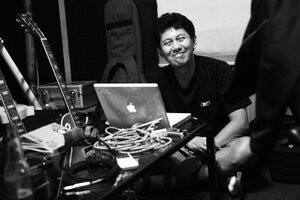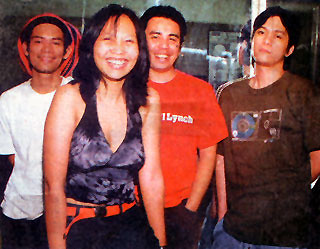Categories: Features
Posted on February 23, 2009
From the electronic pages of our content partner Pulse.PH comes part two of writer Aldus Santos’ profile on Robin Rivera, the professor-turned-record producer who worked on all the Eraserheads albums. In this installment, Robin peels back the layers to reveal the recording techniques behind the classic albums. Robin Rivera also produced this band’s album.

Equal parts studio artist and logistician, Rivera always put emphasis on order and a rigorous program. He would invariably go, “Okay, Marcus, you have to work on this,” or “Ely, we’re gonna do this, so I want you to fix it already by the time you get to the studio.” Luckily, the producer shared, “When they get there, they already had an idea what they were gonna do. It was just a question of, ‘How fast can they execute their ideas?’”
The Eraserheads, needless to say, had very distinct personalities and conducted themselves very differently in the studio. “Ely would always come, and whatever he wanted to do, he had already broken it down to very, very small things. So, he would work on them one after another, these very, very little things. ‘O, what’s next?’ ‘I’m gonna do this guitar overdub.’ ‘Where in the arrangement are you going to do this?’ ‘Sir, it’s here, here, here, and here,’” he said of his singer and mainman, gesturing with his fingers like an agog child in a candy store.
On his drummer, he offered, “Raymund, because he plays drums—it was very hard to punch in drums—most of his performances were from beginning to end. They have to be practically in real time. Raymund, again, he does his homework, he knows exactly what he’s going to do—it’s just a matter of, ‘Can he pull it off?’ [For] each drum part, we’ll do about three, four, five takes. Usually, by the fifth take, he’s happy with it. I just wait ’til he says, ‘Sir, that’s the one!’”
His bassist, because of his proficiency, perhaps necessitated the least amount of looking-after, and he shared, “Buddy, every time he does a repeat, there’s very little variation.” On his beachnik guitar player, meanwhile, “Marcus naman is the opposite of Ely. Marcus doesn’t break things down to small, neat pieces; usually, it’s one big thing. I remember when we did ‘Maskara’ from Carbon Stereoxide. He showed up with this really big idea: ‘Sir, I’m going to play the entire rhythm guitar part backwards. I really practiced hard for it.’ ‘Bahala ka.’” The low-profile frontman of Markus Highway was, in his heyday, utterly unpredictable, to say the very, very least. “’Pag ganyan, you flip the tape over, and what you hear from all the previous tracks is backwards. So, you have to hear it several times before you know what you’re hearing corresponds to which section—just to know where you are! The time indicator was also baliktad, so we were computing,” the producer further elaborated on Makoy’s magic moment, emphasizing, “In Marcus’s case, it’s usually a very, very, very big idea, which, many times, makes it more difficult to pull off than what Ely does—pero, ‘pag nagawa naman, ‘Wow!’ It’s worth the trouble.”
As the boys grew in popularity, so did their creative restlessness. No longer were they simple Fender Stratocaster-loving college kids. They became, with the aid of Robin Rivera, one of the most envied studio bands in the land. From the naked, arguably lackluster aural quality of some of their earlier material—perhaps “Pare Ko,” most certainly “Tindahan ni Aling Nena,” in my opinion—they became the band to beat in studio wizardry.
“There’s one point, I remember—especially towards Natin 99—where, in addition to tape, we all had virtual tracks. They went to Japan, and they all had MDs, or mini-dics. So, they’d record at home, and we’d reload those into the studio systems. ‘Pag nand’yan na, ‘tsaka na lang mag-o-overdub si Ely ng mga stuff that was better done in the studio than at home—acoustic guitars, drums, stuff like that,” Rivera shared, exclaiming, “Anak ng tokwa, we were using twenty-four tracks on tape, and we were laying back at least twelve more into the computer, so we were running anywhere from twenty-four to forty-eight tracks per song! It was really quite amazing. ‘Ang daming gamit, o!’ And this was before PCs, ha. I can’t walk on the floor anymore because there was so much stuff.”
With the technology, of course, came the subtle decline in human interaction, prompted in part by geography. “At that point, they weren’t living together anymore. Dati kasi, they all live within four to five blocks of each other at U.P. Village. But, siyempre, at one point, Raymund moved over to Marikina—he was renting a house with his brothers; Buddy was in another house in U.P. Village; Ely was in Teachers Village naman, because he had moved out of the apartment with Marcus. They weren’t living that closely to each other anymore,” the teacher recounted, emphasizing the great leap in his boys’ circumstances, whereas, “Dati nga, eh—I remember we used to record Mondays and Thursdays yata—Ely and Marcus had the same coding day, Wednesday. I’d pick up Ely first, then Marcus. Dadaanan ko sila, tapos gigisingin ko na sila.”
Indeed, the narratives gave way to free association, and the organic gave way to the constructed. By the sunrise of Sticker Happy, the garage charm of the ‘Heads will be replaced with a much disembodied, almost alien-like sensibility. By Natin 99, that quality would reach even greater heights. However, the ‘Heads weren’t noise artists, nor were they peddlers of dissonance, and their penchant for memorable melodies and turns-of-phrase remained intact.
“People knew that they were already living apart from each other, and maybe you might get that impression, listening to the records,” Rivera guessed. “However, if you listen to the recordings alone, the objective was always to make it seem like everything was originating from one place. That was always my target. Eventually, they were able to set up their little studios at home, and that took over.” As Carbon Stereoxide swung by, it was getting clearer that, not only have the Diliman lads grown in songcraft, they have also developed as studio artists.
However, their celebrated producer shared, “To me, [my role] has stayed pretty much the same. The thing with the Eraserheads was that we recorded so many albums together that, by the latter albums, I didn’t have to tell them anymore what to do. They sort of knew already, eh.” The good professor, who around this time had just started work on his doctorate degree, would have two to three voluminous , er, volumes in the studio. As he flipped through the pages, he would be swathed in the ‘Heads’ technical banter, and he was like a confident parent letting his children loose without any fear of broken limbs or broken china, so to speak.
Needless to say, Robin Rivera had enough academic detachment to appreciate how his most popular clients became not only a phenomenon, but a standing metaphor for a well-lived life as well. “Each album has some connection to what they were going through. Ultra, Circus, and Cutterpillow were the adolescent albums. These were the albums in which you see, most of the themes are all those which happen to people who were experiencing adolescence,” he opined on the ‘Heads’ first triad of releases, continuing, “Pagdating ng Fruitcake, that was another part of their lives: they weren’t kids anymore. They wanted to do something a little more ambitious—something that still had something whimsical, but still had something different.”
“Pagdating ng Sticker Happy,” he offered of their genre-bending release, “they began traveling. They were beginning to see the world; they were getting older. Those songs had something to do with discovering new territories.” He offered the same dissection of Natin 99, saying, “They were experiencing new places, new technology—new this, new that. It’s something that only a twentysomething would write. Unfortunately, the people who started out with them—who were now actually twentysomethings—were more interested in clinging to their adolescence, because that was the part of their lives that was fun. Because, now, they’re working—and work is drudgery.”
“Mas lalo ang Carbon,” he stressed, “eh, nu’ng Carbon, parents na sila, eh! They were starting families. May burdens na, eh.”
As for the group’s dissolution? Well, all good things come to an end. “People started having their own lives. The fans had their lives to live also, so they stopped their dependence on the ‘Heads.” On a more positive note, he added, his brows meeting midway in the depth of his forehead, the memories battling for room in the producer’s restless mind, “Music was never a burden to them.”
source: www.eheadscountdown.com

